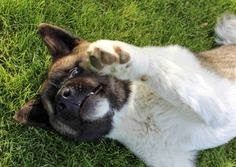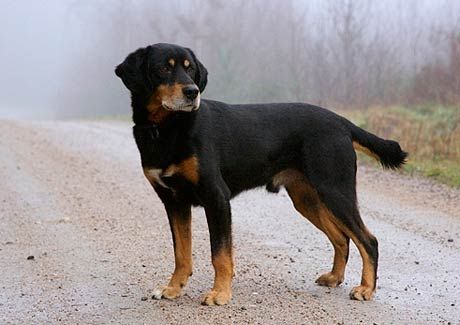To get a healthy pet, never buy a puppy from a irresponsible breeder, puppy mill, or pet store. Find a reputable breeder who tests her breeding dogs for genetic health conditions and good temperaments.
- The Akita is aggressive with other dogs and is especially prone to same-sex aggression.
- The Akita is not a good choice for first-time dog owners.
- Positive socialization and consistent, firm training are essential for the Akita. If he is mishandled or mistreated, he often responds by becoming aggressive.
- The Akita will chase other pets in the house.
- The Akita sheds — a lot!
- Prolonged eye contact is considered a challenge by the Akita, and he may respond aggressively.
- Training the willful Akita can be challenging and requires understanding, experience, and patience. It’s best to work with a trainer familiar with the breed, but be sure to do the training yourself.
 Breed standardsAKC group: Working GroupUKC group: Northern Breed GroupAverage lifespan: 10 – 13 yearsAverage size: 75 – 125 poundsCoat appearance: Triple coat, coarse, short-haired, somewhat stiff and wool-likeColoration: White, pinto, brindle with black maskHypoallergenic: NoOther identifiers: Round and full head, muzzle and cheeks; dark lips and eyes that look to be circled with eyeliner; black nose; broad chest; cat-like feet and fluffy; strong tail that curls over onto backPossible alterations: Long coat, nude/pink or speckled noseComparable Breeds: German Shepherd, Siberian Husky
Breed standardsAKC group: Working GroupUKC group: Northern Breed GroupAverage lifespan: 10 – 13 yearsAverage size: 75 – 125 poundsCoat appearance: Triple coat, coarse, short-haired, somewhat stiff and wool-likeColoration: White, pinto, brindle with black maskHypoallergenic: NoOther identifiers: Round and full head, muzzle and cheeks; dark lips and eyes that look to be circled with eyeliner; black nose; broad chest; cat-like feet and fluffy; strong tail that curls over onto backPossible alterations: Long coat, nude/pink or speckled noseComparable Breeds: German Shepherd, Siberian Husky
History
The Akita originated on the Japanese island of Honshu in the rugged, cold, mountainous Akita prefecture, from which he takes his name. The dogs helped hunters seek out and bring down big game such as boar, elk and the Yezo bear. A pair of Akitas would work as a team, with the male baiting the beast and the female biting at it from behind. Their job was to keep the animal at bay until the hunters arrived to dispatch it. The Akitas also guarded family members and property. The Japanese government declared the Akita a natural monument in 1931.
Akitas became known in the United States after inspirational speaker and writer Helen Keller visited Japan on a speaking tour in 1937 and was presented with an Akita puppy. That puppy died of distemper, but Keller acquired another one who was her companion for the next decade.
Unfortunately, World War II jeopardized the Akita’s existence. Many were killed for food or for their fur. Enough survived, though, that the breed was revived after the war. It was especially popular with American servicemen, many of whom brought the dogs back after a tour of duty in Japan. Those dogs became the foundation of the breed in the United States.
The American Kennel Club recognized the Akita in 1973. The breed currently ranks 49th in AKC registrations, down a bit from 38th in 2000 but still comfortably popular.
Personality
The Akita is a bold and willful dog, naturally wary of strangers but extremely loyal to his family. He is alert, intelligent, and courageous. He tends to be aggressive toward other dogs, especially those of the same sex. He is best suited to a one-dog household. With his family, the Akita is affectionate and playful. He enjoys the companionship of his family and wants to participate in daily activities. He’s mouthy and enjoys carrying toys and household items around. Despite the common belief that he never barks, he is in fact noisy, known to grumble, moan — and, yes, bark if he believes the situation warrants it.
Be aware the Akita’s strong personality can be overwhelming. He is not the dog for a first-time owner, and he is not for the timid. He needs an owner who can provide firm, loving discipline.
Activity is essential for this active breed. He needs plenty of exercise to keep him from becoming bored and, in turn, destructive.
The naturally protective Akita has a propensity to become aggressive if allowed, or if he isn’t raised properly. Training the Akita is essential, and so is proper socialization from an early age. Keep in mind that this breed is stubborn, so extra patience is necessary to teach him proper canine manners.
Health
The Akita, which has an average lifespan of 10 to 12 years, occasionally suffers from microphthalmia, patellar luxation, epilepsy, renal cortical hypoplasia, VKH-like syndrome, polyneuropathy, entropion, and cataract. Care should be taken to prevent some major health problems associated with the breed such as canine hip dysplasia (CHD) and progressive retinal atrophy (PRA). The breed is also prone to some minor health issues, including gastric torsion, hypothyroidism, elbow dysplasia, cruciate ligament rupture, pemphigus, lymphosarcoma, osteosarcoma, and sebaceous adenitis. To identify some of these issues, a veterinarian may run thyroid, hip, eyes, and elbow tests on the dog.
Living Conditions
The Akita will do okay in an apartment if it is sufficiently exercised. It is moderately active indoors and will do best with a large yard.
Exercise
The Akita needs moderate but regular exercise to stay in shape. It should be taken for long daily walks.
Care
An Akita is at its best when kept inside the house with access to outdoors. To keep these dogs obedient, regular mental and physical exercise is very important. The exercise should ideally include running in an enclosed area or long hours of walking. The Akita’s weatherproof coat requires occasional brushing to get rid of dead hair.
Grooming
Brush the Akita’s double coat weekly to keep it clean and remove dead hair. During spring and fall shedding seasons, daily brushing will help to keep excess hair under control. In addition, trim his nails as needed, brush his teeth, and keep the ears clean to prevent infections.
Is this breed right for you?
Because the Akita is known to be aggressive, it requires training during its puppy years. Needing a confident owner, the breed is not recommended for young children and other animals; however, it can adjust to family life if necessary but should always be supervised. Relatively inactive indoors, this breed does alright in an apartment if regularly exercised, although it would be much happier with its own yard to roam in. The Akita should not be allowed to think of itself as the pack leader as this may cause behavioral problems, including food obsessiveness. Shedding heavily twice a year, the Akita does need regular grooming.
Children and other pets
Adults should always supervise interactions between dogs and kids, and this is especially true with this breed. No child could have a more loyal guardian and playmate than an Akita — but a mistreated Akita can become a liability and may even endanger your child’s life. It is imperative to teach youngsters to be respectful and kind in all their interactions with him.
That said, the Akita is suitable for families with older children. He should live in a one-pet household, however, because he is aggressive toward other dogs and will chase other pets.
Did You Know?
The 2009 film “Hachi,” starring Richard Gere, is based on the true story of a Japanese Akita named Hachiko. After his owner’s death, Hachiko waited every day at the train station for the man to return, every day until the end of his own life.
A dream day-in-the-life
The Akita loves its family, so regardless of what it is doing, it will be happiest if constantly surrounded by those it loves the most. The Akita also does best with routine and substance, so you will want to keep its walk and feeding schedule on point. Keep it in check with training commandments, and always show it that you care through verbal kudos and pat downs. Leave it outdoors and give the Akita the idea that it has the job to watch over the home.
 Breed standards
Breed standards







